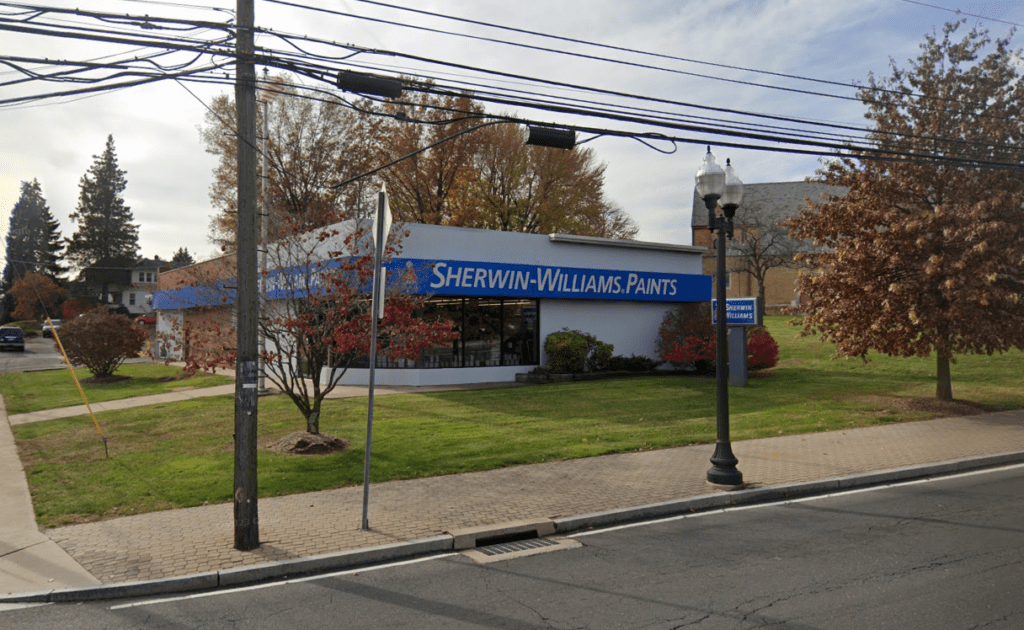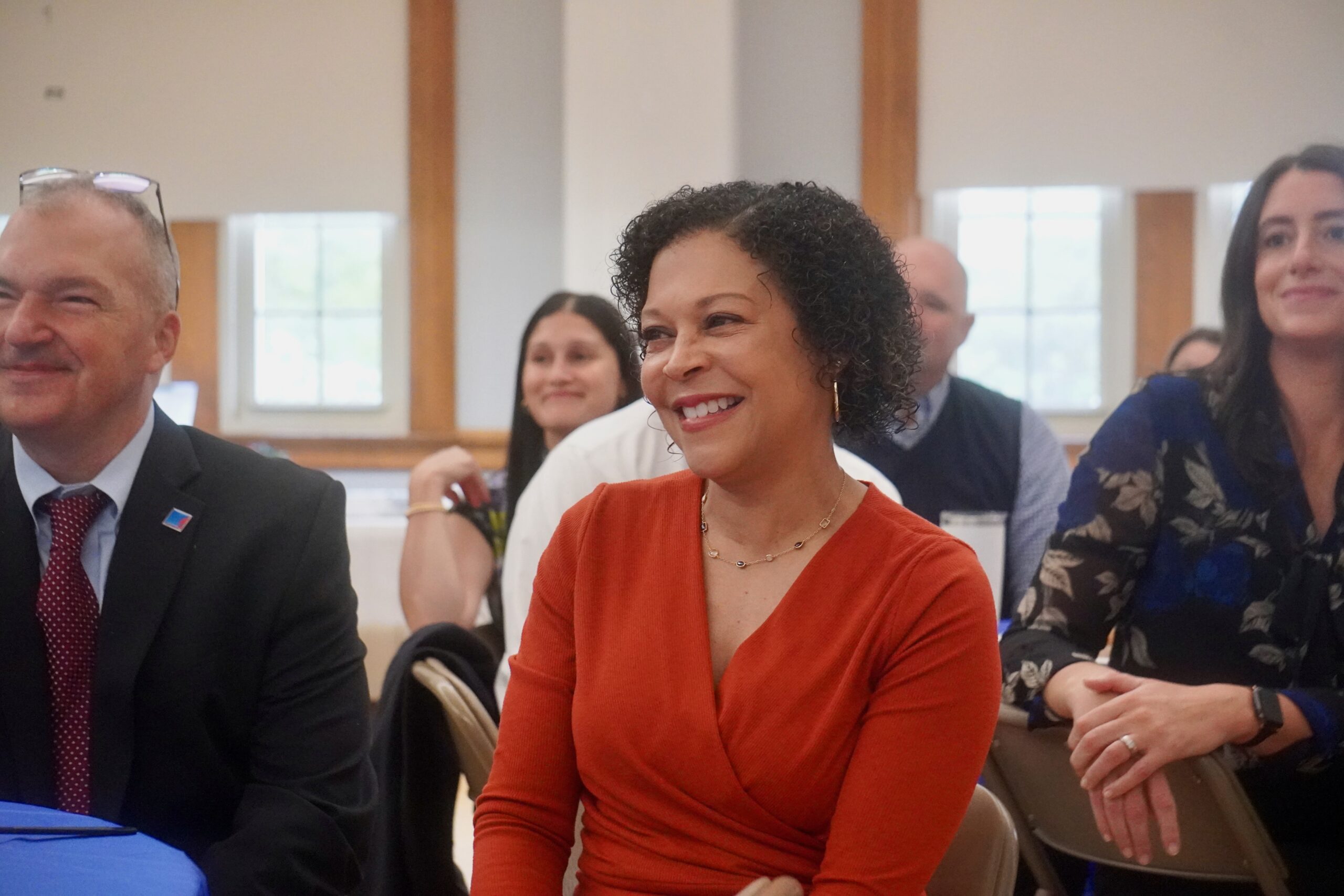From the West Hartford Archives: Modern Living Furniture and Elmwood Post Office

Audio By Carbonatix

Corner of New Britain Avenue and Woodlawn Street, 1950. Courtesy of Noah Webster House & West Hartford Historical Society
Historian Jeff Murray takes a look into West Hartford’s past to uncover some surprising information, stir up some memories, or reflect on how much life has changed – or hasn’t changed at all. Enjoy this week’s ‘From West Hartford’s Archives’ …
By Jeff Murray
Modern Living Furniture opened at the southwest corner of New Britain Avenue and Woodlawn Street in the spring of 1950 in a new building constructed for the new Elmwood post office the previous fall.
For nearly a decade, the Elmwood branch of the post office was hosted in a private residence – the Peard house where the Friendly’s would later be built on New Britain Avenue. When John F. Heneghan was appointed acting postmaster in 1948, he realized that conditions at this house were disorganized, crowded, and overwhelmed.
The south end of West Hartford, like many other neighborhoods and towns in the area, saw explosive growth through and after World War II. In the late 1940s, the post office hired six more workers for a total of 17, a 55% increase, to oversee the much higher demand.
Nine letter carriers and five clerks operated this branch under William Sunheimer. Each year, postal volume was expanding by 10% (and did not stop). In 1949, conditions reached a breaking point and the postal department approved a doubling of the floor space by the construction of new quarters further east.
The builder Peter Tychsen won the contract and built this one-story block at the corner of Woodlawn Street, with the post office leasing one-half and the other being open for commercial space. The post office opened here on Sept. 30, 1949 after a month of delays and almost immediately, five new letter carriers were added to the staff.
The business that occupied the other half of the building – Modern Living Furniture – opened the following spring. At more than 5,000 square feet, the store displayed forest green and slate gray floors and assorted modern furniture, lamps, rugs, fabrics, and wallpaper.
Furniture stores had been around for decades by this point, but the emphasis on sleek and “extreme” designs was a sign of the post-World War II atmosphere of modern living. This was just a few years before the opening of major commercial shopping plazas in Bishops Corner and down the road in Elmwood.
Modern Living Furniture furnished model houses in nearby suburban tracts, like the Longue Vue Acres subdivision behind the current Wolcott Park. This contemporary style highlighted turquoise carpeting, brass globed wall lamps, and lounge chairs (don’t forget the pink bedroom, walnut dressers, and flowery wallpaper!).
There is another historical perspective we can add to this furniture store as well. It was founded in 1950 at this location by Maurice Shlien (1918-2001), whose pioneering work in home furnishings paralleled the employment patterns of many Jewish residents across the United States. Maurice’s father, who was born in Poland and had immigrated to the U.S. around 1903, had founded the Shlien Furniture Store in Middletown.
The turn of the century in Eastern Europe saw violent anti-Semitic pogroms and persecution, political unrest, and general economic hardships that made the U.S. a more attractive destination for migration. Antisemitism was prevalent in the U.S. as well, but borders were more open to migration from this part of Europe until the 1920s when the rise of the second Ku Klux Klan found a foothold in the country, including in Connecticut (and indeed, there was a notable KKK rally at its peak in the mid-1920s in West Hartford).
For those seeking a new start in America, many Jewish immigrants brought skills in trades, like tailoring, carpentry, and furniture making. Jewish immigrants also tended to be more literate and supported by tight-knit communities that allowed a better entrance into small businesses. In many cases, being barred from joining established industries and businesses, Jews turned to starting their own as a way to get around these barriers. In this way, Modern Living Furniture was the continuation of a story that was common among many Jewish families establishing themselves in Connecticut.
In 1961, Modern Living moved from Elmwood to the Silas Deane Highway in Wethersfield and the Elmwood branch of the post office looked to take over this newly unoccupied half. In 1963, the building was renovated and leased by the investment company to the U.S. government so they could expand operations. It was at this location for 30 more years until the summer of 1993 when it closed and was relocated to its current quarters on Shield Street.
Within a few years, Sherwin-Williams opened their store in the old post office location and is still there.

Corner of New Britain Avenue and Woodlawn Street. Google Street view
Jeff Murray was born and raised in West Hartford and has been involved with the Noah Webster House & West Hartford Historical Society since 2011 when he was a high school student and won the Meyer Prize for his essay on local history. Jeff routinely volunteers as local history researcher uncovering information for numerous museum programs such as the West Hartford House Tour and West Hartford Hauntings. Jeff works as a data analyst at Pratt & Whitney.
Like what you see here? Click here to subscribe to We-Ha’s newsletter so you’ll always be in the know about what’s happening in West Hartford! Click the blue button below to become a supporter of We-Ha.com and our efforts to continue producing quality journalism.



